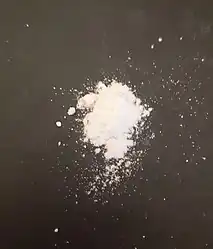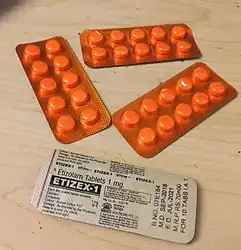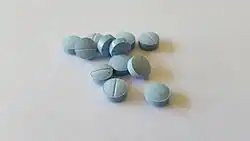Etizolam
 | |
 | |
| Names | |
|---|---|
| Trade names | Etizest, Etilaam, Etizex, Depas, Sedekopan, Pasaden, others |
| Other names | Etiz, etizzy[1] |
IUPAC name
| |
| Clinical data | |
| Drug class | Thienodiazepine |
| Main uses | General anxiety disorder, panic disorder, insomnia[1][2] |
| Side effects | Sleepiness, muscle weakness, poor coordination, fainting, headache, confusion, slurred speech, sexual dysfunction, abuse[2] |
| WHO AWaRe | UnlinkedWikibase error: ⧼unlinkedwikibase-error-statements-entity-not-set⧽ |
| Dependence risk | Moderate[1] |
| Routes of use | By mouth, under the tongue, rectal |
| Duration of action | 5-7 hours |
| Legal | |
| Legal status |
|
| Pharmacokinetics | |
| Bioavailability | 93% |
| Metabolism | Liver |
| Elimination half-life | 3.4 hours[6][7] (main metabolite is 8.2 hours)[8] |
| Excretion | Kidney |
| Chemical and physical data | |
| Formula | C17H15ClN4S |
| Molar mass | 342.85 g·mol−1 |
Etizolam, sold the brand name Depas among others, is medication used for general anxiety disorder, panic disorder, and insomnia.[1][2] It may be used short term but does not appear to be better than benzodiazepines.[9] It is taken by mouth.[1]
Side effects may include sleepiness, muscle weakness, poor coordination, fainting, headache, confusion, slurred speech, and sexual dysfunction.[2] There is also a risk of abuse and dependence.[2] It is a thienodiazepine, which are similar to benzodiazepines.[2] It actions via the benzodiazepine site of the GABAA receptors.[1] It possesses anxiolytic, anticonvulsant, sedative, hypnotic, and skeletal muscle relaxant effects.[2]
Etizolam was patented in 1971 and approved for medical use in 1984.[10][2] As of 2020 it was approved for medical use in Japan, Italy, and India but not in the United States.[1][2] There has been concerns regarding increasing misuse in Europe and the United States.[1] It is also known by a number of street names including Etiz and Etizzy.[1]
Medical uses
- Short-term treatment of insomnia.
- Anxiety disorders such as OCD and general anxiety disorder, however mostly considered a short-term medication to then be used purely on an at need basis[11]
Dosage
Side effects
Long term use may result in blepharospasms,[12] especially in women.[13] Doses of 4 mg or more may cause anterograde amnesia.
In rare cases, erythema annulare centrifugum skin lesions have resulted.[14]
Tolerance and withdrawal
Abrupt or rapid discontinuation from etizolam, as with benzodiazepines, may result in the appearance of the benzodiazepine withdrawal syndrome, including rebound insomnia.[15] Neuroleptic malignant syndrome, a rare event in benzodiazepine withdrawal, has been documented in a case of abrupt withdrawal from etizolam.[16] This is particularly relevant given etizolam's short half life relative to benzodiazepines such as diazepam resulting in a more rapid drug level decrease in blood plasma levels.[17]
Interactions
Itraconazole and fluvoxamine slow down the rate of elimination of etizolam, leading to accumulation of etizolam, therefore increasing its pharmacological effects.[18][19] Carbamazepine speeds up the metabolism of etizolam, resulting in reduced pharmacological effects.[20]
Overdose
Cases of intentional suicide by overdose using etizolam in combination with GABA agonists have been reported.[21][22] Although etizolam has a lower LD50 than certain benzodiazepines, the LD50 is still far beyond the prescribed or recommended dose. Flumazenil, a GABA antagonist agent used to reverse benzodiazepine overdoses, also inhibits the effect of etizolam.[1]
Etizolam overdose deaths are rising - for instance, the National Records of Scotland report on drug-related deaths, 'street' Etizolam was a factor in ("implicated in, or potentially contributed to") 752, or 59%, of drug-related deaths in Scotland in 2019. It is important to highlight that more than one drug contributed to the vast majority of the deaths (by way of comparison, opiates and opioids were a factor in 1092, or 86%, of drug-related deaths).[23]
Pharmacology
Etizolam, a thienodiazepine derivative, is absorbed fairly rapidly, with peak plasma levels achieved between 30 minutes and 2 hours. It has a mean elimination half life of about 3.4 hours.[8][6][7] Etizolam possesses potent hypnotic properties,[24] and is comparable with other short-acting benzodiazepines.[8] Etizolam acts as a full agonist at the benzodiazepine/GABAa receptor to produce its range of therapeutic and adverse effects.[25]
The etizolam molecule differs from a benzodiazepine in that the benzene ring has been replaced by a thiophene ring and triazole ring has been fused, making the drug a thienotriazolodiazepine.[26][27]
According to the Italian prescribing information sheet, etizolam belongs to a new class of diazepines, thienotriazolodiazepines. This new class is easily oxidized, rapidly metabolized, and has a lower risk of accumulation, even after prolonged treatment. Etizolam has an anxiolytic action about 6-8 times greater than that of diazepam. Etizolam produces, especially at higher dosages, a reduction in time taken to fall asleep, an increase in total sleep time, and a reduction in the number of awakenings. During tests, there were no substantial changes in deep sleep; however, it may reduce REM sleep. In EEG tests of healthy volunteers, etizolam showed some similar characteristics to tricyclic antidepressants.[28][29]
Etizolam's main metabolites in humans are alpha-hydroxyetizolam and 8-hydroxyetizolam. alpha-Hydroxyetizolam is pharmacologically active and has a half-life of approximately 8.2 hours.[21]
Society and culture
Brand names
Etilaam, Sedekopan, Etizest, Etizex, Pasaden, Depas, others.
 ~98% pure etizolam powder. The pictured amount is roughly 150 mg, and is thus around 150 standard doses.
~98% pure etizolam powder. The pictured amount is roughly 150 mg, and is thus around 150 standard doses. Etizex brand etizolam tablets
Etizex brand etizolam tablets Etizolam pills
Etizolam pills
Legal status
International drug control conventions
On December 13, 2019, the World Health Organization recommended etizolam be placed in Schedule 4 of the 1971 Convention on Psychotropic Substances.[30] This recommendation was followed by the placement of etizolam into Schedule IV in March 2020.[31]
Australia
Etizolam is not used medically in Australia.[32]
Denmark
Etizolam is controlled in Denmark under the Danish Misuse of Drugs Act.[33]
Germany
Italy
Etizolam is licensed for the treatment of anxiety, insomnia and neurosis as a prescription-only medication.[36]
United Kingdom
In the UK, etizolam has been classified as a Class C drug by the May 2017 amendment to The Misuse of Drugs Act 1971 along with several other designer benzodiazepine drugs.[38]
United States
Etizolam is not authorized by the FDA for medical use in the U.S. However, it currently remains unscheduled at the federal level and is legal for research purposes as of March 2020.[7] As of March 2016, etizolam is a controlled substance in the following states: Alabama,[39] Arkansas,[40] Florida,[41] Georgia (as Schedule IV, whereas all other states listed here prohibit it as a Schedule I substance), Louisiana, Mississippi,[42] Texas,[43] South Carolina,[3] and Virginia.[44] It is controlled in Indiana as of July 1, 2017.[5] It is controlled in Ohio as of February 2018.
Misuse
Etizolam is a drug of potential misuse. Cases of etizolam dependence have been documented in the medical literature.[45] However, conflicting reports from the World Health Organization, made public in 1991, dispute the misuse claims.[46] Since 1991, cases of etizolam misuse and addiction have substantially increased,[47] due to varying levels of accessibility and cultural popularity.[48] Pills being sold as Xanax or other benzodiazepines that are illicitly manufactured may often contain etizolam rather than their listed ingredient [49][50]
See also
References
- 1 2 3 4 5 6 7 8 9 10 11 "Etizolam (INN)" (PDF). WHO. November 2015. Archived (PDF) from the original on 11 July 2021. Retrieved 15 August 2021.
- 1 2 3 4 5 6 7 8 9 "Etizolam" (PDF). Drug Enforcement Administration. March 2020. Archived (PDF) from the original on 3 September 2020. Retrieved 16 August 2021.
- 1 2 "Controlled Substance Schedule | SCDHEC". www.scdhec.gov. Archived from the original on 2019-03-30. Retrieved 2019-03-20.
- ↑ "Arizona HB2033 | 2017 | Fifty-third Legislature 1st Regular". LegiScan. Archived from the original on 2020-11-17. Retrieved 2021-08-04.
- 1 2 "Ellington's bill banning two deadly drugs could soon be law - State of Indiana House of Representatives". www.indianahouserepublicans.com. Archived from the original on 2020-11-17. Retrieved 2021-08-04.
- 1 2 "Etizolam". www.drugbank.ca. Archived from the original on 2020-03-06. Retrieved 2020-09-03.
- 1 2 3 U.S. Drug Enforcement Administration (March 2020). "Drug & Chemical Evaluation - Etizolam" (PDF). U.S. Department of Justice. Archived (PDF) from the original on September 2020.
- 1 2 3 Fracasso, C.; Confalonieri, S.; Garattini, S.; Caccia, S. (1991-02-01). "Single and multiple dose pharmacokinetics of etizolam in healthy subjects". European Journal of Clinical Pharmacology. 40 (2): 181–185. doi:10.1007/BF00280074 (inactive 31 May 2021). ISSN 1432-1041. PMID 2065698. Archived from the original on 2017-05-19. Retrieved 2021-08-04.
{{cite journal}}: CS1 maint: DOI inactive as of May 2021 (link) - 1 2 Tripathi, K. D. (31 October 2018). Essentials of Medical Pharmacology. Jaypee Brothers Medical Publishers. p. 433. ISBN 978-93-5270-499-6. Archived from the original on 28 August 2021. Retrieved 16 August 2021.
- ↑ Fischer J, Ganellin CR (2006). Analogue-based Drug Discovery. John Wiley & Sons. p. 536. ISBN 9783527607495. Archived from the original on 2021-08-28. Retrieved 2021-08-04.
- ↑ Lopedota A, Cutrignelli A, Trapani A, Boghetich G, Denora N, Laquintana V, et al. (May 2007). "Effects of different cyclodextrins on the morphology, loading and release properties of poly (DL-lactide-co-glycolide)-microparticles containing the hypnotic agent etizolam". Journal of Microencapsulation. 24 (3): 214–24. doi:10.1080/02652040601058152. PMID 17454433. S2CID 31434550.
- ↑ Wakakura M, Tsubouchi T, Inouye J (March 2004). "Etizolam and benzodiazepine induced blepharospasm". Journal of Neurology, Neurosurgery, and Psychiatry. 75 (3): 506–7. doi:10.1136/jnnp.2003.019869. PMC 1738986. PMID 14966178.
- ↑ Wakakura, M.; Tsubouchi, T.; Inouye, J. (2004-03-01). "Etizolam and benzodiazepine induced blepharospasm". Journal of Neurology, Neurosurgery & Psychiatry. 75 (3): 506–507. doi:10.1136/jnnp.2003.019869. ISSN 0022-3050. PMC 1738986. PMID 14966178.
- ↑ Kuroda K, Yabunami H, Hisanaga Y (January 2002). "Etizolam-induced superficial erythema annulare centrifugum". Clinical and Experimental Dermatology. 27 (1): 34–6. doi:10.1046/j.0307-6938.2001.00943.x. PMID 11952667. S2CID 36251540.
- ↑ Hirase M, Ishida T, Kamei C (November 2008). "Rebound insomnia induced by abrupt withdrawal of hypnotics in sleep-disturbed rats". European Journal of Pharmacology. 597 (1–3): 46–50. doi:10.1016/j.ejphar.2008.08.024. PMID 18789918.
- ↑ Kawajiri M, Ohyagi Y, Furuya H, Araki T, Inoue N, Esaki S, et al. (February 2002). "[A patient with Parkinson's disease complicated by hypothyroidism who developed malignant syndrome after discontinuation of etizolam]" [A patient with Parkinson's disease complicated by hypothyroidism who developed malignant syndrome after discontinuation of etizolam]. Rinsho Shinkeigaku = Clinical Neurology (in 日本語). 42 (2): 136–9. PMID 12424963. Archived from the original on 2020-11-26. Retrieved 2021-08-04.
- ↑ Greenblatt DJ (February 1985). "Elimination half-life of drugs: value and limitations". Annual Review of Medicine. 36 (1): 421–7. doi:10.1146/annurev.me.36.020185.002225. PMID 3994325.
- ↑ Araki K, Yasui-Furukori N, Fukasawa T, Aoshima T, Suzuki A, Inoue Y, et al. (August 2004). "Inhibition of the metabolism of etizolam by itraconazole in humans: evidence for the involvement of CYP3A4 in etizolam metabolism". European Journal of Clinical Pharmacology. 60 (6): 427–30. doi:10.1007/s00228-004-0789-1. PMID 15232663. S2CID 22970567.
- ↑ Suzuki Y, Kawashima Y, Shioiri T, Someya T (December 2004). "Effects of concomitant fluvoxamine on the plasma concentration of etizolam in Japanese psychiatric patients: wide interindividual variation in the drug interaction". Therapeutic Drug Monitoring. 26 (6): 638–42. doi:10.1097/00007691-200412000-00009. PMID 15570188. S2CID 12164244.
- ↑ Kondo S, Fukasawa T, Yasui-Furukori N, Aoshima T, Suzuki A, Inoue Y, et al. (May 2005). "Induction of the metabolism of etizolam by carbamazepine in humans". European Journal of Clinical Pharmacology. 61 (3): 185–8. doi:10.1007/s00228-005-0904-y. PMID 15776275. S2CID 9612361.
- 1 2 Nakamae T, Shinozuka T, Sasaki C, Ogamo A, Murakami-Hashimoto C, Irie W, et al. (November 2008). "Case report: Etizolam and its major metabolites in two unnatural death cases". Forensic Science International. 182 (1–3): e1-6. doi:10.1016/j.forsciint.2008.08.012. PMID 18976871.
- ↑ Høiseth G, Tuv SS, Karinen R (November 2016). "Blood concentrations of new designer benzodiazepines in forensic cases". Forensic Science International. 268: 35–38. doi:10.1016/j.forsciint.2016.09.006. PMID 27685473.
- ↑ "Drug-related deaths in Scotland 2018" (PDF). National Records of Scotland. Archived (PDF) from the original on 2021-08-02. Retrieved 2021-08-04.
- ↑ Nakamura J, Mukasa H (December 1992). "Effects of thienodiazepine derivatives, etizolam and clotiazepam on the appearance of Fm theta". The Japanese Journal of Psychiatry and Neurology. 46 (4): 927–31. doi:10.1111/j.1440-1819.1992.tb02862.x. PMID 1363923. S2CID 11263866.
- ↑ Yakushiji T, Fukuda T, Oyama Y, Akaike N (November 1989). "Effects of benzodiazepines and non-benzodiazepine compounds on the GABA-induced response in frog isolated sensory neurones". British Journal of Pharmacology. 98 (3): 735–40. doi:10.1111/j.1476-5381.1989.tb14600.x. PMC 1854765. PMID 2574062.
- ↑ Niwa T, Shiraga T, Ishii I, Kagayama A, Takagi A (September 2005). "Contribution of human hepatic cytochrome p450 isoforms to the metabolism of psychotropic drugs". Biological & Pharmaceutical Bulletin. 28 (9): 1711–6. doi:10.1248/bpb.28.1711. PMID 16141545.
- ↑ Catabay A, Taniguchi M, Jinno K, Pesek JJ, Williamsen E (1 March 1998). "Separation of 1,4-Benzodiazepines and Analogues Using Cholesteryl-10-Undecenoate Bonded Phase in Microcolumn Liquid Chromatography". Journal of Chromatographic Science. 36 (3): 111–118. doi:10.1093/chromsci/36.3.111.
- ↑ "Depas". Archived from the original on September 23, 2015. Retrieved October 31, 2015.
- ↑ PubChem. "Etizolam". pubchem.ncbi.nlm.nih.gov. Archived from the original on 2020-08-24. Retrieved 2020-09-03.
- ↑ "Letter of WHO Director-General to UN Secretary-General dated November 15th 2019" (PDF). www.who.int. Archived (PDF) from the original on 2021-08-28. Retrieved 2021-08-04.
- ↑ "News: March 2020 – Recently scheduled benzodiazepines Flualprazolam and Etizolam associated with multiple post-mortem and DUID cases in UNODC EWA". Archived from the original on 2021-07-14. Retrieved 2021-08-04.
- ↑ "Warnings over counterfeit benzodiazepines". NSW Health. Archived from the original on 2021-08-28. Retrieved 2021-08-04.
- ↑ "Bekendtgørelse om euforiserende stoffer". retsinformation.dk (in dansk). Archived from the original on 2013-10-04. Retrieved 2016-11-21.
- ↑ "Verordnungsentwurf der Bundesregierung" [Federal draft regulation] (PDF). Bundesministerium für Gesundheit (Federal Ministry of Health) (in Deutsch). Archived from the original (PDF) on 18 March 2016.
- ↑ "Gesetz über den Verkehr mit Betäubungsmitteln" [Law on traffic with tranquillizers]. Bundesministerium der Justiz und für Verbraucherschutz (Federal Ministry of Justice and Consumer Protection) (in Deutsch). Archived from the original on 2021-07-30. Retrieved 2021-08-04.
- ↑ "DEPAS - Etizolam". 2017-08-31. Archived from the original on 2018-05-15. Retrieved 2018-05-14.
- ↑ PubChem. "Etizolam". pubchem.ncbi.nlm.nih.gov. Archived from the original on 2020-08-24. Retrieved 2021-03-06.
- ↑ "The Misuse of Drugs Act 1971 (Amendment) Order 2017". Archived from the original on 2021-05-11. Retrieved 2021-08-04.
- ↑ "Alabama Code Title 20. Food, Drugs, and Cosmetics § 20-2-23". Findlaw. Archived from the original on 2018-07-24. Retrieved 2021-08-04.
- ↑ "List of Controlled Substances" (PDF). State of Arkansas. Archived from the original (PDF) on 2 February 2011.
- ↑ "Statutes & Constitution: Online Sunshine". www.leg.state.fl.us. Archived from the original on 2021-03-02. Retrieved 2022-03-14.
- ↑ "HB1231 (As Sent to Governor) - 2014 Regular Session". billstatus.ls.state.ms.us. Archived from the original on 2014-09-09. Retrieved 2021-08-04.
- ↑ "Health and Safety Code Chapter 481. Texas Controlled Substances Act". statutes.capitol.texas.gov. Archived from the original on 2019-07-09. Retrieved 2019-07-12.
- ↑ "18VAC110-20-322. Placement of Chemicals in Schedule I". Commonwealth of Virginia. 2 December 2015. Archived from the original on 12 March 2016. Retrieved 11 March 2016.
- ↑ Gupta S, Garg B (2014). "A case of etizolam dependence". Indian Journal of Pharmacology. 46 (6): 655–6. doi:10.4103/0253-7613.144943. PMC 4264086. PMID 25538342.
- ↑ "WHO Expert Committee on Drug Dependence" (PDF). Archived (PDF) from the original on 2015-06-10. Retrieved 2021-08-04.
- ↑ Allison, David (20 April 2018). "How to tackle Dundee's fake valium epidemic". BBC News. Archived from the original on 22 June 2020. Retrieved 4 August 2021.
- ↑ Guirguis, Amira. "Novel psychoactive substances: understanding the new illegal drug market". Pharmaceutical Journal. Archived from the original on 2019-04-11. Retrieved 2021-08-04.
- ↑ "Drug Data Xanax". DrugData.org. Archived from the original on 6 May 2019. Retrieved 9 April 2020.
- ↑ "Warnings over counterfeit benzodiazepines". NSW Health. Archived from the original on 2021-08-28. Retrieved 2021-08-04.
External links
| Identifiers: |
|---|
- Inchem.org - Etizolam Archived 2020-12-04 at the Wayback Machine